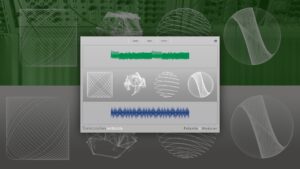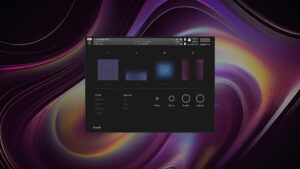Noon Instruments describes Vessels as “an exploration of object resonance and sonic materiality.” It may sound poetic, but it’s an unusually precise summary of what this instrument actually is. This is a deeply textural, character-driven synth instrument built from re-amped analog/digital synths, metallic resonances, tape, cassette, and boutique processing. It’s cinematic, tactile, often hazy in the best possible way, and full of colours you don’t hear in most synth-based libraries.
Across almost 460 presets through three distinct banks — Convergent, Divergent, and Relics — Vessels delivers a palette that feels both experimental and musically immediate. And yes: the vibe is very much my thing.
First Impressions: Organic Depth Meets Experimental Design
Vessels won me over almost instantly. The concept alone speaks to everything I love:
“There’s something about the three-dimensionality you get when a sound is recorded through microphones in a space… it gives you an organic twist you can’t fake.”
Rather than relying on reverb plugins to create a sense of physicality, Vessels captures that physicality at the source — vibrating oil drums, resonant thunder sheets, multiple mic perspectives, re-amped cabinets, and cassette transfers. It’s the kind of experimental, tactile signal chain that gives sounds a lived-in quality.
And importantly: the library’s interface is minimal, beautiful, and genuinely inspiring. Clean design, grainy textures, no clutter — just what you need to sculpt creatively.
Preset Banks & Sound World
Divergent — Re-amped Synth Core
This bank re-amps synths through 180-watt stereo cabinets, capturing them with Sanken CU-41s and SM57s, plus optional MS-20 external overdrive.
The result is a range of tones that feel alive, physical, and punchy:
“It’s remarkable how punchy, full, and coherent these sounds stay — even with movement and drift.”
I kept coming back to the differences between mic layers. The Sanken mics feel round, soft, warm. The SM57s lean brighter, more present. The MS-20 mic path adds a crispy retro edge that I loved way more than I expected.
For scoring, electronic music, video game textures, or lo-fi aesthetics, Divergent is a goldmine. The differences between the two mic paths are subtle yet significant—they don’t reinvent the source sound, but they shape it. Each mic perspective adds its own tint and feel, giving you exactly the control you need to make a patch sit perfectly in your mix.
Convergent — More Controlled Than Expected — Yet Still Full of Character
Going into the Convergent bank, I had a clear expectation of what I’d find — and honestly, I was preparing myself for chaos. These are synths being driven into metallic objects like oil drums, thunder sheets, and even a seismic-contact-mic–captured “mega” thunder sheet. On paper, that sounds like a recipe for resonance, brashness, and possibly uncontrollable harmonic noise.
But the reality was the complete opposite.
“I was kind of worried it would be too resonant and chaotic… completely opposite thing.”
What really surprised me was just how mature, controlled, and musically usable these sounds are. Instead of overwhelming clangs or explosive ringing, you get subtle, sculpted tonal shifts — each material adding its own colour without ever drowning out the musical core of the sound.
- The resonances are subtle
- The sound remains coherent
- The character feels intentional, not destructive
- Each material adds a different emotional perspective on the same core tone
This gives Convergent a genuinely unique sonic identity: grainy, hazy, grey-toned, slightly chilly, but still full and musical.
Each Layer Has Its Own Personality — and They’re All Tastefully Captured
Layer 4 (Seismic Mic):
The deepest, darkest, most atmospheric layer of the bank. Thick low end, gorgeous weight, and almost a “sub-oscillator through metal” vibe. It’s dramatic without being muddy — a perfect layer for intros, builds, or darker textures.
Layer 3 (Thunder Sheet):
A slightly brighter, radiating tone with a rounded, muted quality. It sits in this beautiful lo-fi space — scooped mid-focused sound — without ever feeling exaggerated, weak, or piercing.
Layer 2 (Oil Drum):
More forward, a bit more resonant — this is the layer that leans furthest into that metallic character. But even then, it isn’t brash. It’s refined, warm, slightly trashy in the top end in a way that adds shape and presence rather than harshness.
Relics — Gorgeous Lo-Fi Character, Tape Patina, and Some of the Best Textures in Vessels
Relics may only contain 20 presets, but it leaves an outsized impact. Where Convergent and Divergent reshape the source through physical spaces and resonating materials, Relics dives straight into pure lo-fi nostalgia: ¼-inch tape, cassette, micro-cassette, and boutique pedals. It’s the most character-driven part of the library, and one that immediately stands apart.
From the very first preset, the tone is unmistakable — warm, worn, saturated, and full of personality.
Relics embraces degradation in a thoughtful way, using different re-recording stages to create a beautifully imperfect world of wobble, grit, and harmonic haze.
A Beautiful Sound, But With One Limitation
As far as I could tell, the pitch wobble and instability (outside of possible LFO influences) are baked into the recordings, not generated by the engine. That means when the wobble goes too far, there’s no way to reduce it. In many patches that instability is part of the charm, but at times I wish I could control the intensity or amount.
“There’s something magical about that dark cassette vibe — a wall of sound full of tiny, beautiful details.”
Relics is a small bank, but the textures it produces are among the most memorable in Vessels. It expands the library’s palette into a world of patina, nostalgia, and beautifully broken sound design — and it’s a highlight for anyone who loves authentic lo-fi tone. Perfect for ambient, cinematic mood pieces, or retro-inspired scoring.
In fact, I found myself wishing this bank were much larger — or that Noon Instruments might someday build an entire dedicated library around these lo-fi principles.
The Four Mic Layers — A High-Fidelity Toolkit
One of Vessels’ most powerful features is its four mic/source layers, switchable across all presets:
- Layer 1 – Raw synth
- Layer 2 – Oil drum (Convergent) / Sanken re-amp (Divergent) / Tape (Relics)
- Layer 3 – Thunder sheet (Convergent) / SM57 re-amp (Divergent) / Cassette + pedals (Relics)
- Layer 4 – Low-frequency “sub-oscillator” thunder sheet mic (Convergent) / MS-20 destruction (Divergent) / Micro-cassette (Relics)
This layering system gives shockingly refined control for the texturally thoughtful composer. The differences aren’t always drastic — but they matter:
“This is a high-fidelity toolkit. Slight changes in tone and colour can completely change how a sound sits in a mix.”
It’s rare to have synth sounds where you can “switch microphones” like a real recording session. In practice, it’s incredibly useful.
Sound Quality & Character
Across the board, Vessels sounds:
- Full and solid in the body
- Grainy or hazy in the top end (in a good way)
- Physical, like sound has weight
- Musical even when broken, distorted, or unstable
- Punchy even when layered or unison-spread
Several times I found myself pausing just to appreciate the tone shaping:
“It’s super difficult to make grainy veiled sounds that still feel full — but Vessels nails it.”
And for retro-inspired or video-game-style cues, I was in heaven. I repeatedly drifted into mini-compositions just from stumbling onto a preset.
Interface & Workflow
The UI is minimal, elegant, and quick to navigate. Just my kind of a thing. I did wish for one improvement:
- Layer labels or tooltips showing what each layer represents (oil drum, SM57, tape, etc.)
It’s in the manual, but having optional in-UI labels would help newer users and save time.
Otherwise:
- Distortion and warmth options sound genuinely good
- Harmony or interval control is powerful (and crucially not baked into samples 🙏🏻)
- Convolution reverb is rich and varied, not overdone
- Pulse/LFO page allows tasteful and subtle movement without chaos
Everything feels considered.
Who is Vessels For?
Vessels is a dream for composers or producers who want:
- Cinematic pads, soundscapes, pulses, and textures
- Video-game-style synth grit (with maybe a darker or modern tint)
- Ambient or experimental color
- Lo-fi and nostalgic tones
- Unique mic-based shaping to pair with a hybrid orchestral sound
- Physical, organic synth sound design
If you crave pristine, clean, modern EDM synths — this isn’t that.
If you want character, vibe, and a sense of place, Vessels delivers in spades.
Pricing & Requirements
- Full version: £99 (check for sales)
- ~25.7 GB compressed
- ~460 presets
- Requires Kontakt Player 7.7.2+
- macOS 12–14 & Windows 10/11 supported
The size is bigger than you’d expect from synth sources — because each preset bank is truly sampled differently. You’re getting multiple genuine re-recordings, not just DSP variations.
Final Thoughts
Vessels is one of the most inspiring darker-toned synth-based Kontakt instruments I’ve used in a long time. It excels not because it’s flashy, but because it has a soul. The mixture of experimental recording techniques, tactile layers, and beautifully curated presets makes it a library you can get lost in for hours.
“This is just my type of stuff. Grainy, gritty, retro, cinematic — and incredibly musical.”
If your work thrives on atmosphere, texture, and depth, Vessels is absolutely worth exploring.
Get ‘Vessels’ here: https://www.nooninstruments.com/vessels
Prefer video?
Full review: https://youtu.be/KGMwe0TKTn8
No talking edit: https://youtu.be/uh-u-wWbjkw





